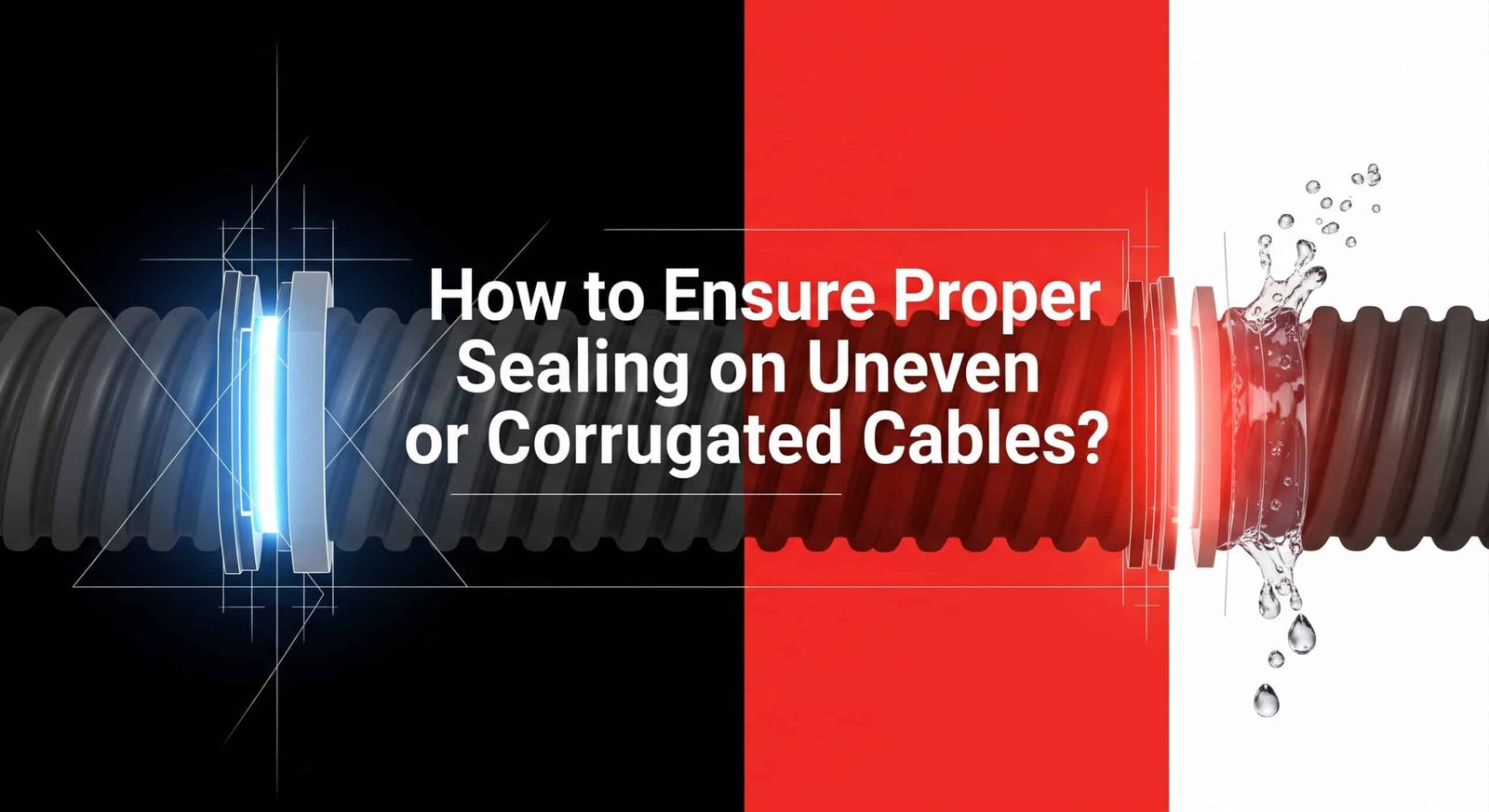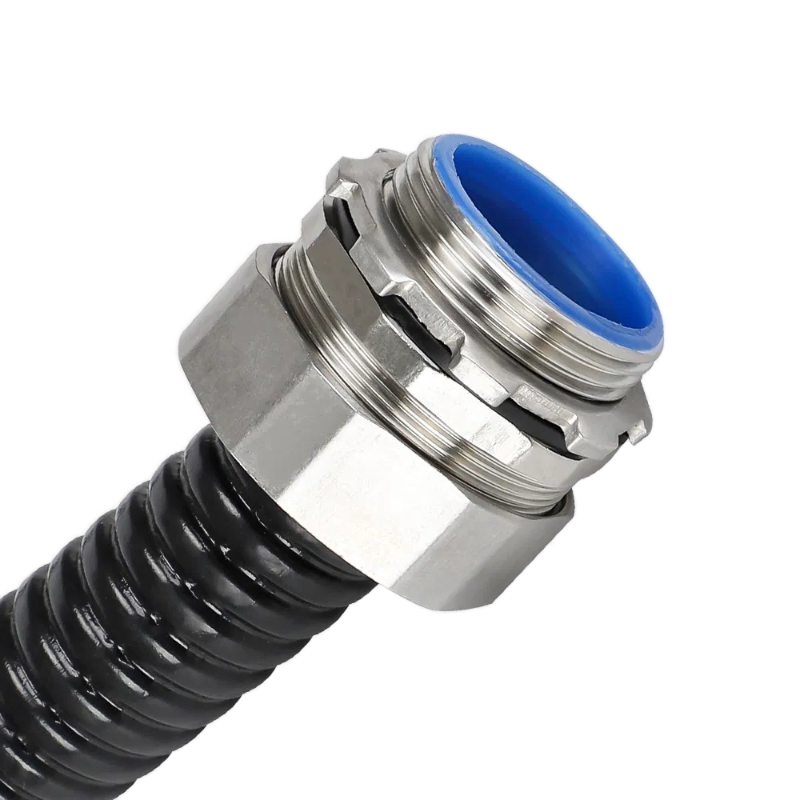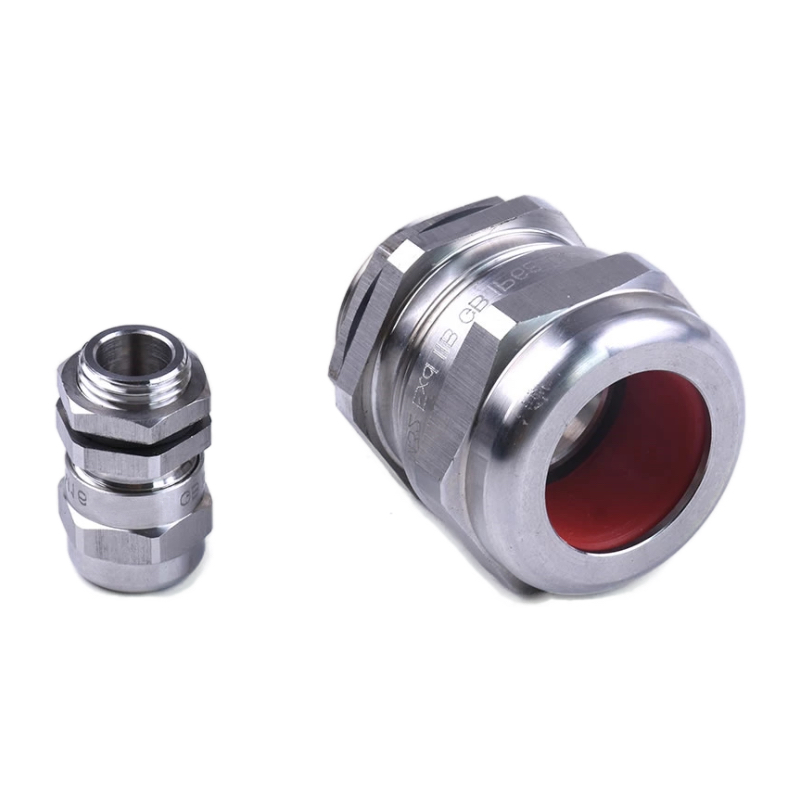Improper sealing on corrugated and uneven cables leads to catastrophic moisture ingress, electrical failures, equipment damage, and safety hazards that can shut down entire facilities, cause fires, and result in millions of dollars in losses, making proper sealing techniques absolutely critical for maintaining system integrity and preventing costly downtime in industrial applications.
Proper sealing on uneven or corrugated cables requires specialized cable glands with flexible sealing inserts, stepped compression systems, and conformable elastomers that adapt to cable surface irregularities, combined with proper installation techniques including surface preparation, correct torque application, and verification testing to achieve reliable IP65/IP66 protection1 and long-term environmental sealing performance.
Having solved sealing challenges on everything from armored cables in North Sea oil platforms to corrugated solar cables in Arizona desert installations, I’ve learned that standard sealing approaches fail spectacularly on irregular cable surfaces. Let me share the proven techniques that ensure reliable sealing regardless of cable surface conditions.
Table of Contents
- What Makes Corrugated and Uneven Cables Challenging to Seal?
- Which Cable Gland Types Work Best for Irregular Surfaces?
- What Installation Techniques Ensure Reliable Sealing?
- How Do You Test and Verify Sealing Performance?
- What Common Mistakes Should You Avoid?
- FAQs About Sealing Corrugated Cables
What Makes Corrugated and Uneven Cables Challenging to Seal?
Corrugated and uneven cables create sealing challenges due to surface irregularities that prevent uniform contact between standard sealing systems and cable surfaces, creating potential leak paths where moisture, dust, and contaminants can bypass sealing elements, while the varying cable diameters and surface textures require specialized sealing solutions that can conform to irregular geometries and maintain consistent compression across the entire sealing interface.
Understanding these challenges is essential for selecting appropriate sealing solutions and installation methods.
Surface Irregularity Issues
Corrugated Cable Geometry: The alternating ridges and valleys in corrugated cables create air pockets and uneven contact surfaces that standard O-rings and sealing washers cannot accommodate.
Armored Cable Variations: Steel wire armored (SWA)2 and aluminum wire armored (AWA) cables have irregular outer surfaces from the armor winding that creates sealing gaps.
Braided Shield Cables: External braided shields create textured surfaces with varying diameters that challenge conventional sealing methods.
Cable Jacket Irregularities: Manufacturing variations, cable pulling damage, and aging can create surface imperfections that compromise sealing integrity.
Dimensional Variability Challenges
Diameter Variations: Corrugated cables often have significant diameter differences between peaks and valleys, making it difficult to achieve consistent sealing pressure.
Tolerance Stack-up3: Manufacturing tolerances in both cables and cable glands can compound, creating situations where standard sealing methods are inadequate.
Temperature Effects: Thermal expansion and contraction can exacerbate sealing challenges by changing cable dimensions and creating stress concentrations.
Pressure Differentials: Environmental pressure changes can force contaminants through inadequately sealed interfaces.
Material Compatibility Issues
Chemical Compatibility: Different cable jacket materials require compatible sealing compounds and elastomers to prevent degradation and seal failure.
Temperature Ratings: Sealing materials must maintain flexibility and sealing properties across the full operating temperature range.
UV Resistance: Outdoor applications require sealing materials that resist UV degradation without becoming brittle or losing elasticity.
Aging Characteristics: Long-term compatibility between cable materials and sealing compounds affects service life and reliability.
Environmental Exposure Factors
Moisture Ingress Risks: Inadequate sealing allows moisture penetration that can cause insulation breakdown, corrosion, and electrical failures.
Dust and Particle Contamination: Poor sealing permits dust ingress that can interfere with electrical connections and equipment operation.
Chemical Exposure: Industrial environments expose sealed interfaces to chemicals that can degrade inadequate sealing systems.
Mechanical Stress: Vibration, thermal cycling, and mechanical movement stress sealed interfaces and can cause seal failure over time.
Common Cable Types Requiring Special Sealing
| Cable Type | Surface Characteristics | Sealing Challenges | Typical Applications |
|---|---|---|---|
| Corrugated Solar Cables | Deep ridges and valleys | Large diameter variations | Solar installations |
| SWA Armored Cables | Irregular armor winding | Uneven compression | Industrial power distribution |
| Flexible Conduit | Spiral corrugations | Continuous diameter changes | Machine connections |
| Braided Shield Cables | Textured outer surface | Variable contact pressure | Control and instrumentation |
| Submarine Cables | Multiple armor layers | Complex geometry | Marine applications |
Marcus, an electrical contractor working on a large solar farm in Phoenix, Arizona, was struggling with moisture ingress issues on corrugated DC cables. Standard cable glands were failing to seal properly against the deep corrugations, causing ground faults and system shutdowns during monsoon season. We provided specialized solar cable glands with stepped sealing inserts that conform to the corrugated surface geometry, achieving IP67 protection that has eliminated moisture problems for over two years of operation. 😊
Which Cable Gland Types Work Best for Irregular Surfaces?
Cable glands designed for irregular surfaces feature multi-stage sealing systems with flexible inserts, stepped compression rings, and conformable elastomers that adapt to surface variations, including specialized designs like corrugated cable glands with profiled sealing elements, armored cable glands with dual-compression systems, and universal glands with adjustable sealing mechanisms that accommodate various cable geometries while maintaining reliable environmental protection.
Selecting the right gland type is crucial for achieving proper sealing on challenging cable surfaces.
Specialized Corrugated Cable Glands
Profiled Sealing Inserts: Custom-molded sealing elements with internal profiles that match common corrugated cable geometries for optimal surface contact.
Stepped Compression Systems: Multiple compression stages that progressively conform to cable surface irregularities while maintaining consistent sealing pressure.
Flexible Sealing Materials: Advanced elastomers that maintain sealing properties while conforming to complex cable surface geometries.
Extended Sealing Length: Longer sealing zones that bridge multiple corrugations to ensure reliable environmental protection.
Armored Cable Gland Solutions
Dual Compression Design: Separate inner and outer sealing systems that accommodate both the cable core and armor irregularities.
Armor Clamping Systems: Mechanical clamping mechanisms that secure armor while providing environmental sealing around irregular surfaces.
Barrier Sealing: Multiple sealing barriers that prevent moisture ingress even if one sealing stage is compromised.
Strain Relief Integration: Combined sealing and strain relief that accommodates armor termination requirements.
Universal Sealing Solutions
Adjustable Sealing Inserts: Modular sealing systems with interchangeable inserts for different cable types and surface conditions.
Progressive Compression: Tapered compression systems that automatically adjust to cable diameter variations during installation.
Multi-Material Sealing: Combination of different elastomer durometers to optimize sealing performance across varying surface conditions.
Field-Customizable Options: Sealing systems that can be modified on-site to accommodate specific cable configurations.
Advanced Sealing Technologies
Liquid Sealant Systems: Injectable sealing compounds that cure in place to create custom sealing profiles for irregular surfaces.
Expanding Foam Seals: Foam-based sealing systems that expand to fill voids and conform to complex geometries.
Putty-Based Sealing: Moldable sealing compounds that can be shaped to match specific cable surface irregularities.
Hybrid Sealing Systems: Combinations of mechanical and chemical sealing methods for maximum reliability.
Material Selection Considerations
Elastomer Properties: Shore hardness4, compression set resistance, and temperature stability affect sealing performance on irregular surfaces.
Chemical Resistance: Compatibility with cable jacket materials and environmental exposure conditions.
UV Stability: Long-term resistance to ultraviolet radiation for outdoor applications.
Temperature Range: Maintaining sealing properties across full operating temperature ranges.
Performance Specifications
IP Rating Achievement: Verified ability to achieve IP65, IP66, or IP67 ratings on specified cable types and surface conditions.
Pressure Testing: Validated performance under specified pressure differentials and environmental conditions.
Temperature Cycling: Proven reliability through temperature cycling tests that simulate real-world conditions.
Long-term Aging: Accelerated aging tests that verify long-term sealing performance and material stability.
Application-Specific Recommendations
| Application Type | Recommended Gland Type | Key Features | Typical IP Rating |
|---|---|---|---|
| Solar Installations | Corrugated cable glands | UV resistance, profiled seals | IP67 |
| Industrial Power | Armored cable glands | Dual compression, barrier sealing | IP66 |
| Marine Applications | Marine-grade universal | Corrosion resistance, salt spray rating | IP68 |
| Hazardous Areas | Explosion-proof with sealing | ATEX certification, flame paths | IP65 |
| Food Processing | Hygienic design glands | FDA materials, washdown capability | IP69K |
What Installation Techniques Ensure Reliable Sealing?
Reliable sealing installation requires systematic surface preparation including cleaning and inspection, proper cable gland selection and sizing, correct assembly sequence with appropriate torque application, verification of sealing insert positioning, and post-installation testing to confirm environmental protection performance, combined with documentation of installation parameters and ongoing maintenance procedures to ensure long-term sealing reliability.
Following proven installation procedures is essential for achieving design sealing performance.
Pre-Installation Preparation
Cable Surface Inspection: Thoroughly examine cable surfaces for damage, contamination, or irregularities that could affect sealing performance.
Cleaning Procedures: Remove all dirt, oil, moisture, and debris from cable surfaces using appropriate cleaning solvents and methods.
Dimensional Verification: Measure cable outer diameter at multiple points to verify compatibility with selected cable gland specifications.
Material Compatibility Check: Confirm compatibility between cable jacket materials and sealing compound chemistry.
Proper Gland Selection and Sizing
Cable Diameter Matching: Select glands with sealing ranges that accommodate both minimum and maximum cable diameters.
Thread Size Verification: Ensure proper thread engagement with enclosure or panel mounting requirements.
Environmental Rating Confirmation: Verify that selected glands meet or exceed required IP rating and environmental specifications.
Certification Requirements: Confirm any required certifications (ATEX, UL, marine) are valid for the specific installation.
Assembly and Installation Sequence
Component Preparation: Inspect all gland components for damage and ensure proper orientation of sealing inserts.
Cable Threading: Carefully thread cable through gland components without damaging sealing surfaces or cable jacket.
Sealing Insert Positioning: Position sealing inserts to align with cable surface features for optimal contact and compression.
Progressive Assembly: Assemble gland components in correct sequence, ensuring proper alignment and positioning throughout.
Torque Application Procedures
Torque Specification Compliance: Apply manufacturer-specified torque values using calibrated torque wrenches5 for consistent results.
Progressive Tightening: Use progressive tightening sequences to ensure even compression and avoid over-stressing sealing components.
Verification Methods: Verify proper compression through visual inspection of sealing insert deformation and gap closure.
Documentation Requirements: Record torque values and installation parameters for quality control and maintenance records.
Sealing Verification Techniques
Visual Inspection: Examine sealing interfaces for proper compression, alignment, and absence of gaps or voids.
Pressure Testing: Perform pressure tests using appropriate test equipment to verify IP rating compliance.
Leak Detection: Use leak detection methods including bubble testing or electronic leak detection for critical applications.
Environmental Testing: Subject installations to environmental conditions (temperature, humidity) to verify sealing performance.
Quality Control Measures
Installation Checklists: Use standardized checklists to ensure all installation steps are completed properly.
Inspector Verification: Have qualified inspectors verify critical installations before system commissioning.
Test Documentation: Maintain detailed records of all testing and verification activities for compliance and warranty purposes.
Corrective Action Procedures: Establish procedures for addressing any sealing deficiencies discovered during testing.
Common Installation Errors to Avoid
Insufficient Surface Preparation: Failing to properly clean cable surfaces before installation compromises sealing performance.
Incorrect Torque Application: Over-tightening can damage sealing components while under-tightening allows leakage.
Misaligned Sealing Inserts: Improper positioning of sealing elements prevents effective surface contact.
Contaminated Sealing Surfaces: Allowing contamination during installation creates leak paths and seal failure.
How Do You Test and Verify Sealing Performance?
Testing and verifying sealing performance requires systematic approaches including initial pressure testing at specified levels, environmental exposure testing under actual operating conditions, long-term monitoring through periodic inspections, and documentation of test results to ensure continued compliance with IP rating requirements and environmental protection standards throughout the installation lifecycle.
Comprehensive testing validates sealing effectiveness and identifies potential issues before they cause system failures.
Initial Pressure Testing Procedures
Test Pressure Selection: Apply test pressures appropriate for the specified IP rating and environmental conditions.
Test Duration Requirements: Maintain test pressure for sufficient duration to identify slow leaks and seal degradation.
Test Medium Selection: Use appropriate test media (air, water, or specialized fluids) based on application requirements.
Pressure Monitoring: Continuously monitor pressure during testing to detect any pressure drops indicating seal failure.
Environmental Simulation Testing
Temperature Cycling: Subject sealed assemblies to temperature cycles that simulate actual operating conditions.
Humidity Exposure: Test sealing performance under high humidity conditions to verify moisture protection.
Chemical Exposure: Expose seals to relevant chemicals and contaminants to verify long-term compatibility.
UV Exposure Testing: Test outdoor installations under accelerated UV exposure to verify material stability.
Leak Detection Methods
Bubble Testing: Submerge pressurized assemblies in water and observe for bubble formation indicating leakage.
Electronic Leak Detection: Use electronic leak detectors for precise identification of small leaks and their locations.
Helium Leak Testing: Employ helium mass spectrometry for ultra-sensitive leak detection in critical applications.
Dye Penetrant Testing: Use colored dyes to identify leak paths and assess sealing effectiveness.
Performance Verification Standards
IP Rating Compliance: Verify that installations meet specified IP rating requirements through standardized testing procedures.
Industry Standards: Comply with relevant industry standards (IEC, NEMA, JIS) for environmental protection testing.
Application-Specific Requirements: Meet any special testing requirements for specific industries or applications.
Certification Validation: Ensure testing methods and results support any required certifications or approvals.
Ongoing Monitoring Procedures
Periodic Inspections: Establish regular inspection schedules to monitor sealing performance over time.
Performance Trending: Track sealing performance parameters to identify degradation trends before failure occurs.
Environmental Monitoring: Monitor environmental conditions that could affect sealing performance.
Maintenance Scheduling: Schedule preventive maintenance based on inspection results and performance trends.
Documentation and Record Keeping
Test Records: Maintain detailed records of all testing activities, results, and any corrective actions taken.
Installation Documentation: Document installation parameters, materials used, and any deviations from standard procedures.
Maintenance Logs: Keep comprehensive maintenance records including inspection results and any seal replacements.
Compliance Documentation: Maintain documentation necessary for regulatory compliance and warranty claims.
Failure Analysis Procedures
Root Cause Analysis: Investigate any sealing failures to identify root causes and prevent recurrence.
Material Analysis: Analyze failed sealing materials to understand degradation mechanisms and improve future selections.
Installation Review: Review installation procedures and training to identify potential improvement opportunities.
Design Modifications: Implement design changes based on failure analysis results to improve future installations.
What Common Mistakes Should You Avoid?
Common mistakes that compromise sealing performance include using standard cable glands on irregular surfaces, inadequate surface preparation, incorrect torque application, mismatched sealing materials, ignoring environmental factors, insufficient testing verification, and poor maintenance practices, all of which can lead to premature seal failure, environmental ingress, equipment damage, and safety hazards that could have been prevented through proper selection, installation, and maintenance procedures.
Avoiding these mistakes is essential for reliable long-term sealing performance.
Selection and Specification Errors
Wrong Gland Type Selection: Using standard cable glands on corrugated or irregular cables without considering surface compatibility.
Inadequate Environmental Rating: Selecting glands with insufficient IP ratings for the actual environmental exposure conditions.
Material Incompatibility: Choosing sealing materials that are incompatible with cable jacket materials or environmental chemicals.
Size Mismatching: Selecting glands that are too large or too small for the actual cable diameter range.
Installation Procedure Mistakes
Insufficient Surface Preparation: Failing to properly clean cable surfaces before installation, leaving contaminants that prevent proper sealing.
Incorrect Assembly Sequence: Assembling gland components in wrong order or orientation, preventing proper sealing function.
Improper Torque Application: Over-tightening that damages sealing components or under-tightening that allows leakage.
Sealing Insert Misalignment: Positioning sealing inserts incorrectly relative to cable surface features.
Environmental Consideration Oversights
Temperature Range Neglect: Ignoring actual operating temperature ranges when selecting sealing materials.
Chemical Exposure Underestimation: Failing to account for all chemicals and cleaning agents that may contact sealing surfaces.
UV Degradation Ignorance: Not considering UV exposure effects on outdoor installations and sealing material selection.
Pressure Differential Oversight: Underestimating pressure differentials that sealing systems must withstand.
Testing and Verification Shortcomings
Inadequate Testing: Performing insufficient testing to verify sealing performance under actual operating conditions.
Wrong Test Methods: Using inappropriate test methods that don’t accurately simulate real-world conditions.
Test Documentation Gaps: Failing to properly document test procedures, results, and any corrective actions taken.
Acceptance Criteria Errors: Using incorrect acceptance criteria that don’t ensure adequate sealing performance.
Maintenance and Monitoring Deficiencies
Inspection Neglect: Failing to establish and follow regular inspection schedules for sealing performance monitoring.
Warning Sign Ignorance: Ignoring early warning signs of seal degradation such as minor moisture ingress or visible damage.
Preventive Maintenance Avoidance: Waiting for seal failure rather than performing preventive maintenance based on inspection results.
Record Keeping Failures: Inadequate documentation of maintenance activities and sealing performance history.
Cost-Related Mistakes
False Economy: Choosing cheaper sealing solutions that result in higher total lifecycle costs due to premature failure.
Over-Specification: Selecting unnecessarily expensive solutions when simpler approaches would provide adequate performance.
Maintenance Cost Ignorance: Failing to consider long-term maintenance costs when making initial sealing system selections.
Failure Cost Underestimation: Not accounting for the full cost of sealing failures including downtime, repairs, and safety risks.
Training and Knowledge Gaps
Installer Training Deficiencies: Inadequate training of installation personnel on proper sealing techniques and procedures.
Material Knowledge Gaps: Insufficient understanding of sealing material properties and compatibility requirements.
Application-Specific Ignorance: Lack of knowledge about specific requirements for different industries and applications.
Technology Updates: Failing to stay current with new sealing technologies and improved installation methods.
Hassan, who manages a chemical processing facility in Rotterdam, Netherlands, experienced repeated sealing failures on corrugated steam lines despite using high-quality cable glands. Investigation revealed that installers were using standard installation procedures without accounting for the corrugated surface geometry. We provided specialized training on corrugated cable sealing techniques and supplied profiled sealing inserts that conform to the steam line corrugations. Since implementing proper procedures, they haven’t had a single sealing failure in over 18 months of operation.
Conclusion
Proper sealing of corrugated and uneven cables requires specialized cable glands, correct installation techniques, and comprehensive testing to ensure reliable environmental protection. Success depends on understanding the unique challenges these cable types present and selecting appropriate solutions.
The key to reliable sealing lies in matching the sealing system to the specific cable surface characteristics and environmental requirements. At Bepto, we provide specialized cable glands and technical expertise to help customers achieve reliable sealing on even the most challenging cable configurations, ensuring long-term system reliability and environmental protection.
FAQs About Sealing Corrugated Cables
Q: Can I use regular cable glands on corrugated cables?
A: Regular cable glands typically cannot achieve proper sealing on corrugated cables due to surface irregularities that prevent uniform contact. Specialized corrugated cable glands with profiled sealing inserts are required to conform to the cable surface and achieve reliable environmental protection.
Q: What IP rating can I achieve with corrugated cable sealing?
A: With proper specialized cable glands and installation techniques, you can achieve IP67 or even IP68 ratings on corrugated cables. The key is using glands specifically designed for irregular surfaces with appropriate sealing insert profiles and materials.
Q: How do I know if my corrugated cable sealing is working properly?
A: Perform pressure testing at the specified IP rating level, conduct visual inspections for proper sealing insert compression, and monitor for any signs of moisture ingress or environmental contamination. Regular testing and inspection are essential for verifying ongoing sealing performance.
Q: What’s the most common mistake when sealing corrugated cables?
A: The most common mistake is using standard cable glands without considering the surface irregularities. This results in air gaps and leak paths that compromise environmental protection. Always use specialized glands designed for corrugated surfaces.
Q: How often should I inspect sealing on corrugated cables?
A: Inspection frequency depends on environmental conditions, but typically ranges from quarterly in harsh environments to annually in moderate conditions. Critical applications may require monthly inspections, while protected indoor installations might need only annual checks.
-
Understand the International Protection (IP) rating system, which classifies the degree of protection against intrusion from solid objects and liquids. ↩
-
Learn about the construction and applications of Steel Wire Armoured (SWA) cable, designed for use in power networks and underground systems. ↩
-
Explore the concept of tolerance stack-up analysis, an engineering method used to calculate the effects of accumulated variation in part assemblies. ↩
-
Discover how the Shore durometer scale is used to measure the hardness of polymers, elastomers, and rubbers. ↩
-
Understand the importance of using calibrated torque wrenches to apply a precise amount of torque and ensure the integrity of fastened joints. ↩





